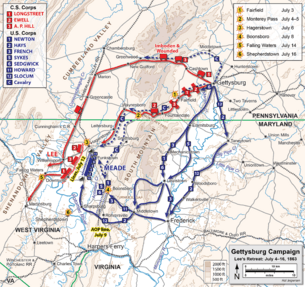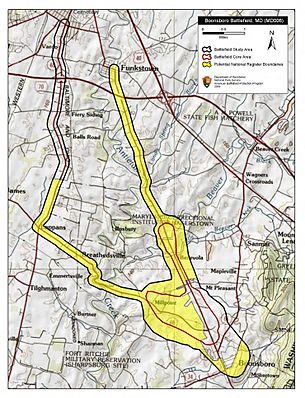Battle of Boonsboro facts for kids
Quick facts for kids Battle of Boonsboro |
|||||||
|---|---|---|---|---|---|---|---|
| Part of the American Civil War | |||||||
|
|||||||
| Belligerents | |||||||
| Commanders and leaders | |||||||
| Alfred Pleasonton | J.E.B. Stuart | ||||||
| Strength | |||||||
| Divisions | Divisions | ||||||
| Casualties and losses | |||||||
| 100 | |||||||
The Battle of Boonsboro happened on July 8, 1863, in Washington County, Maryland. It was part of the American Civil War and took place during the Retreat from Gettysburg. This battle was a small but important part of the larger Gettysburg Campaign.
After their big defeat at the Battle of Gettysburg, Confederate soldiers led by Robert E. Lee began to retreat. They were heading back to Virginia. To protect their retreat, Confederate cavalry (soldiers on horseback) guarded the mountain passes. They fought against Union cavalry and some supporting infantry (soldiers on foot). This battle was one of several cavalry fights in the areas around Boonsboro, Hagerstown, and Williamsport.
What Was the Battle of Boonsboro About?
This battle was a crucial part of the Confederate army's retreat. Maj. Gen. J.E.B. Stuart, a Confederate cavalry leader, had a tough job. He needed to find the Union cavalry and stop them. If the Union cavalry cut off Lee's path, his army would be trapped. Lee's escape route was towards Williamsport and the Potomac River.
Why Was This Battle Important?
The Battle of Boonsboro became the biggest and longest cavalry battle in Maryland during the Gettysburg Campaign. It happened on Wednesday, July 8, 1863, along the National Road. Stuart's main goal was to buy time for General Lee's army to get away safely.
How Did the Battle Unfold?
Stuart led five cavalry brigades (groups of soldiers) from the direction of Funkstown and Williamsport. They first met Union resistance at Beaver Creek Bridge. This bridge was about 4.5 miles (7.2 km) north of Boonsboro.
By 11 a.m., the Confederate cavalry had pushed forward. They reached several muddy fields. The ground was so wet that fighting on horseback was almost impossible. This forced Stuart's troopers and the Union cavalry divisions under Hugh Judson Kilpatrick and John Buford to get off their horses. They had to fight like infantry soldiers.
By the middle of the afternoon, the Union's left side, led by Kilpatrick, started to struggle. The Union soldiers were running low on ammunition. The Confederates kept pushing harder. Stuart's advance finally stopped around 7 p.m. This was when Union infantry soldiers arrived. They were the first infantry to join the battle since Gettysburg.
Stuart decided to pull his forces back north to Funkstown. Even though he retreated, he had achieved his goal. He had gained another day for Lee's army to continue its retreat. Two days later, Stuart would again slow down the Union chase at the Battle of Funkstown.



